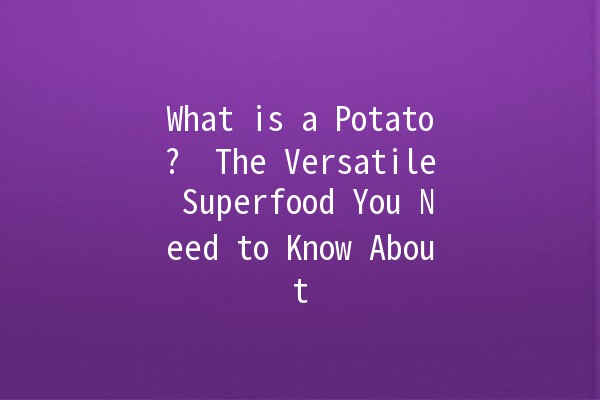Potatoes, a staple food in many cultures, have been around for centuries and are loved for their versatility and rich nutritional profile. In this article, we will explore everything you need to know about potatoes, including their types, nutritional benefits, culinary uses, and practical tips to enhance your cooking experience.
The History of Potatoes
Potatoes originated from the Andean region of South America, particularly modernday Peru and Bolivia. They were cultivated by indigenous peoples over 7,000 years ago. The Spanish brought potatoes back to Europe in the late 16th century, and since then, they have become one of the world's most widely grown root vegetables. Today, potatoes are grown in over 125 countries, and their varieties number in the thousands.
Types of Potatoes
Understanding the different types of potatoes can help you choose the right one for your culinary needs. Here are some common categories:
Commonly known as “Idaho” or “Russet” potatoes, these varieties are high in starch and low in moisture. They are perfect for baking, frying, and mashing.

These potatoes, including red and fingerling varieties, have a smooth, moist texture, making them ideal for boiling, roasting, and adding to salads.
Such as Yukon Gold, these potatoes are versatile and can be used for almost any cooking method, including baking, frying, and boiling.
This category includes purple, orange, and even blue potatoes, which can add a colorful touch to your dishes.
Nutritional Benefits of Potatoes
Potatoes are not only delicious but also packed with a variety of nutrients. Here are some key nutritional benefits:
Potatoes are an excellent source of vitamins C and B
Potatoes provide essential minerals, including potassium, which helps regulate blood pressure and heart health.
With the skin on, potatoes are a great source of dietary fiber, which aids in digestion and promotes a healthy gut.
Potatoes contain antioxidants, such as flavonoids, which can combat oxidative stress and reduce the risk of chronic diseases.
Culinary Uses of Potatoes
Potatoes are incredibly versatile and can be used in various dishes. Here are some popular culinary applications:
This classic comfort food is made by boiling potatoes until tender, then mashing them with butter, milk, and seasonings. It pairs well with gravies and meats.
French fries are a favorite side dish worldwide, made by cutting starchy potatoes into strips and frying them until crispy.
A chilled potato salad can be a refreshing side dish for picnics and barbecues. Combine boiled potatoes with mayonnaise, mustard, and various seasonings.
Thinly sliced potatoes fried until crispy make for a popular snack. They come in various flavors and can be made at home or bought from stores.
Baking potatoes can be topped with various ingredients, such as sour cream, cheese, or chili, creating a satisfying meal.
ProductivityBoosting Tips When Cooking with Potatoes
Cooking with potatoes can be more efficient and enjoyable with these productivityboosting tips:
Peel and chop your potatoes a day in advance and store them in water in the refrigerator. This saves time when you're ready to cook.
Example:
If you're planning a large dinner for family or friends, prep your potatoes the night before to ease your workload on the day of the event.
Using a pressure cooker can significantly reduce cooking time for potatoes. You can steam or cook them in less than half the time compared to traditional boiling.
Example:
If you're making mashed potatoes, using a pressure cooker can cut the cooking time from 20 minutes to just 5 minutes.
Cook a large batch of potatoes at once and store them in the refrigerator or freezer. You can reheat and use them for various meals throughout the week.
Example:
Prepare a big pot of mashed potatoes and freeze individual portions for use in future meals, saving you time on weeknights.
Using proper kitchen tools such as a goodquality peeler, sharp knives, and a sturdy cutting board can make the process of preparing potatoes faster and more efficient.
Example:
A good peeler will cut down on prep time and ensure you get a smooth finish for dishes like potato salad.
Experimenting with different cooking methods can keep your meals exciting and allow you to use the same ingredient in various ways.
Example:
Alongside mashed potatoes, try roasting, frying, or making potato pancakes. This variety keeps meals interesting and enjoyable.
Common Questions About Potatoes
Yes, potatoes are healthy when consumed as part of a balanced diet. They provide essential vitamins, minerals, and fiber, but portion control is essential, especially with methods like frying.
Store potatoes in a cool, dark, and dry place. Avoid placing them in the refrigerator, as this can alter their flavor and texture.
Absolutely! Potato skins are rich in nutrients, including fiber. Just ensure they are cleaned thoroughly before cooking.
Look for signs such as sprouting, soft spots, or a wrinkled appearance. If they have a foul odor or an unusual color, it's best to discard them.
Raw potatoes can last several weeks when stored properly. Cooked potatoes should be consumed within 35 days if refrigerated.
Steaming or microwaving potatoes can help retain more nutrients compared to boiling, as they are cooked quickly and with minimal water exposure.
Potatoes are an incredibly versatile and nutritious food that has held a place in our diets for centuries. By understanding different varieties, nutritional benefits, and culinary applications, you can elevate your cooking experience. Remember, with some easy productivity tips, you can make the most out of this superfood in your daily meals. Enjoy experimenting with various dishes and discover how much you can do with potatoes!